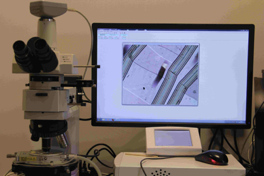Facilities
Still being updated …
Nanostructure Laboratory, Institute of Physics, Pedagogical University of Cracow (NanoLab-PUC)
In NanoLab-PUC, the research was focused on the “Investigating the thermodynamic properties of selected thin-film systems and of compounds/alloys of selected d- and f-metals” led by prof. Hoa Kim Ngan Nhu-Tarnawska.
We aim at obtaining important new knowledge about the fundamental and practical properties of materials for applications in advanced technology, such as thin-films and multi-layers based on e.g. Fe3O4, TiO2/VOx, (Fe, Pd) Cu, as well as compounds/alloys of selected d- and f- metals (U-Mo/Zr/Pt/Pd/Nb) and their hydrides.
Experiments have been carried out using e.g. the high-energy ion beam (1-2MeV), low temperatures (down to 50mK), atomic force microscopy (AFM), scanning tunneling microscopy (STM), in a cooperation with the research groups in Krakow, Darmstadt and Prague.
In NanoLab-PUC, the research was focused on the “Investigating the thermodynamic properties of selected thin-film systems and of compounds/alloys of selected d- and f-metals” led by prof. Hoa Kim Ngan Nhu-Tarnawska.
We aim at obtaining important new knowledge about the fundamental and practical properties of materials for applications in advanced technology, such as thin-films and multi-layers based on e.g. Fe3O4, TiO2/VOx, (Fe, Pd) Cu, as well as compounds/alloys of selected d- and f- metals (U-Mo/Zr/Pt/Pd/Nb) and their hydrides.
Experiments have been carried out using e.g. the high-energy ion beam (1-2MeV), low temperatures (down to 50mK), atomic force microscopy (AFM), scanning tunneling microscopy (STM), in a cooperation with the research groups in Krakow, Darmstadt and Prague.
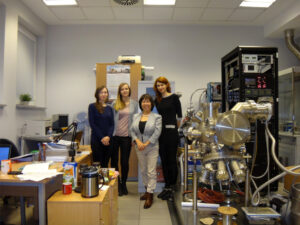
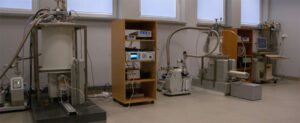
Mössbauer Spectroscopy Laboratory
Mössbauer Spectroscopy Laboratory is equipped with a top-class Mössbauer spectrometer RENON MsAa-4. The measurements are performed in the temperature range from 2 K to 1000 K and in the magnetic field up to 7 Tesla. The research topics focus on the subject of local structural properties (phase composition, electric field gradient), electronic properties (valence, oxidation state) and magnetic properties (ordering temperature, anisotropy and internal magnetic hyperfine field structure) of solid state materials containing mössbauer resonance atoms, mainly iron. Analysis of the Mössbauer spectra is based on advanced fitting procedures with full Hamiltonian of hyperfine interactions by means of the MOSGRAF software suite.
Mössbauer Spectroscopy Laboratory is equipped with a top-class Mössbauer spectrometer RENON MsAa-4. The measurements are performed in the temperature range from 2 K to 1000 K and in the magnetic field up to 7 Tesla. The research topics focus on the subject of local structural properties (phase composition, electric field gradient), electronic properties (valence, oxidation state) and magnetic properties (ordering temperature, anisotropy and internal magnetic hyperfine field structure) of solid state materials containing mössbauer resonance atoms, mainly iron. Analysis of the Mössbauer spectra is based on advanced fitting procedures with full Hamiltonian of hyperfine interactions by means of the MOSGRAF software suite.
Mt Suhora Observatory
Mt Suhora Observatory houses our 60-cm optical telescope. We use this telescope mainly for monitoring variable stars, including pulsating stars, eclipsing binary systems, as well as some extragalactic quasars. We take photometric data by means of the CCD technique to collect photons from outer space and based on the shape of the light curves obtained, we conclude on the parameters of the stars we observe. We are taking data as part of our individual projects, as well as a part of a collaboration of international standing. We are part of the Whole Earth Telescope collaboration. To date we contributed to many excellent discoveries and terrific results in stellar astronomy.
Mt Suhora Observatory houses our 60-cm optical telescope. We use this telescope mainly for monitoring variable stars, including pulsating stars, eclipsing binary systems, as well as some extragalactic quasars. We take photometric data by means of the CCD technique to collect photons from outer space and based on the shape of the light curves obtained, we conclude on the parameters of the stars we observe. We are taking data as part of our individual projects, as well as a part of a collaboration of international standing. We are part of the Whole Earth Telescope collaboration. To date we contributed to many excellent discoveries and terrific results in stellar astronomy.
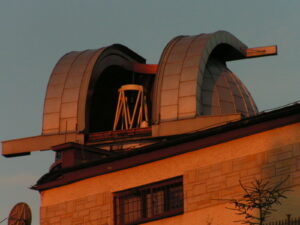
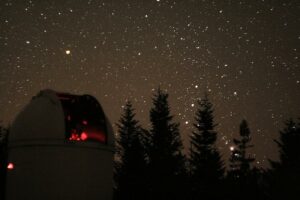
Astronomy Lab
Classes of the astronomical laboratory take place after dark. Students learn about astronomy in the form of theoretical and computer exercises. On average, 1/3 of classes take place outdoor enjoying the real sky. Observational and computer equipment allow for making direct and remote observations. Photos, catalogues and multimedia collection offer additional support to cover the universe, particularly on cloudy nights.
Classes of the astronomical laboratory take place after dark. Students learn about astronomy in the form of theoretical and computer exercises. On average, 1/3 of classes take place outdoor enjoying the real sky. Observational and computer equipment allow for making direct and remote observations. Photos, catalogues and multimedia collection offer additional support to cover the universe, particularly on cloudy nights.
Ferroics Lab.
Ferroics i.e.: Ferroelectrics, antiferroelectrics, ferroelastics and ferromagnetics that are materials used in a huge range of electronic devices with a world market of tens of billions of dollars per annum. Applications include piezoelectric devices, microwave communications filters, uncooled infra-red detectors and imagers, displays and other optical devices, memories and the rapidly growing field of micro-electro-mechanical devices (MEMS). In our laboratory we concentrates on investigation of lattice dynamics and critical phenomena in polar materials, ferroelectrics, antiferroelectrics and relaxor ferroelectrics.
Ferroics i.e.: Ferroelectrics, antiferroelectrics, ferroelastics and ferromagnetics that are materials used in a huge range of electronic devices with a world market of tens of billions of dollars per annum. Applications include piezoelectric devices, microwave communications filters, uncooled infra-red detectors and imagers, displays and other optical devices, memories and the rapidly growing field of micro-electro-mechanical devices (MEMS). In our laboratory we concentrates on investigation of lattice dynamics and critical phenomena in polar materials, ferroelectrics, antiferroelectrics and relaxor ferroelectrics.
